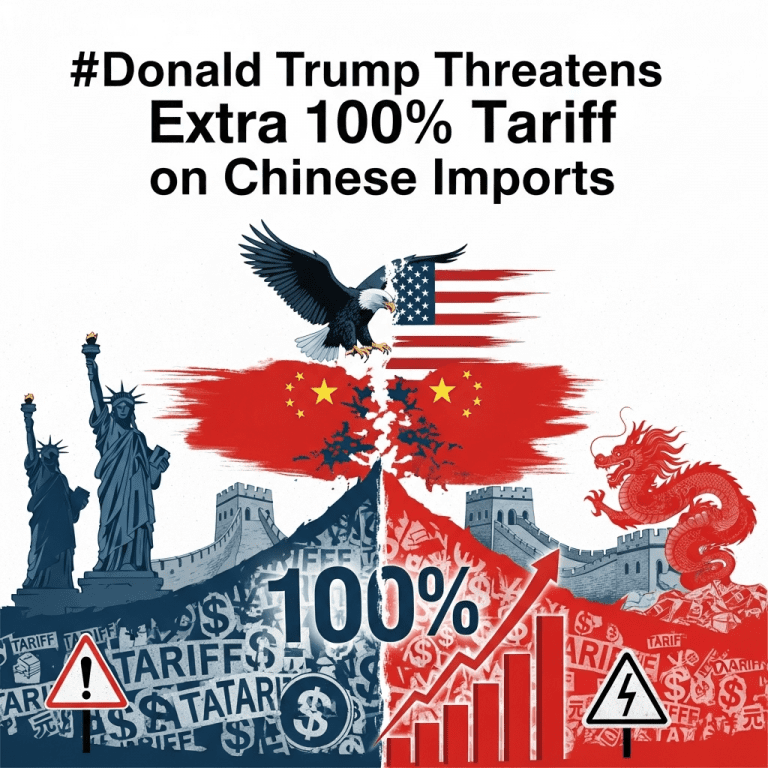Markets are on high alert as Donald Trump threatens extra 100% tariff on Chinese imports, escalating tensions between the world’s two largest economies. This bold move, announced as a potential retaliatory measure, could significantly reshape global trade relations and impact a wide range of sectors, from manufacturing to technology.
How Donald Trump Threatens Extra 100% Tariff Impacts Global Trade
According to recent statements from Trump’s campaign, the proposition of an additional 100% tariff on Chinese goods is a direct response to what he perceives as unfair trade practices by Beijing. The prospect of such a significant tariff increase has already stirred concerns among international economists, investors, and policy makers. This aggressive stance not only intensifies the ongoing US-China trade war, but raises questions about the future of global supply chains and international commerce.
If implemented, the 100% tariff would dramatically increase the cost of Chinese products in the US market. Key industries, including electronics, automotive, and consumer goods, could face severe disruptions. US companies with deep supply chain dependencies in China are already assessing potential strategies to mitigate risk. Global diversification is being revisited as an urgent necessity.
Market Reactions and Investor Sentiment
Financial markets responded swiftly to news that Donald Trump threatens extra 100% tariff against China. U.S. equity indices faced heightened volatility, with shares of companies reliant on Chinese imports taking the brunt of the impact. The possibility of retaliatory tariffs from Beijing also looms, adding further downside risk for sectors with strong export ties to China.
According to analysts at several leading financial institutions, heightened trade friction will likely drive increased risk aversion. Portfolio managers are closely monitoring market analysis and preparing for possible adjustments to allocations in sectors vulnerable to trade disruptions. The currency market reflected investor concern as the US dollar gained strength on safe-haven flows.
Underlying Motivations for the 100% Tariff Threat
Examining the motivations behind Trump’s latest proposition reveals a mixture of economic and political drivers. Trump has frequently criticized the US trade deficit with China, alleging unfair trade practices, currency manipulation, and intellectual property theft. The announcement that Donald Trump threatens extra 100% tariff aims to demonstrate a forceful approach to addressing these longstanding grievances.
On the political front, the stance is set to resonate with parts of the electorate concerned about offshoring and job losses. Trump’s advocacy for domestic manufacturing has been a hallmark of his economic platform. Trade negotiations with China have consistently formed a pillar in his diplomatic efforts, and latest threats mark a renewed attempt to exert leverage in ongoing disputes.
Implications for Businesses and Consumers
The ramifications of a potential 100% tariff are extensive. American businesses dependent on Chinese raw materials or finished goods may see rising input costs, pressuring profit margins. These increases could eventually be passed along to consumers, who might face higher prices for a variety of everyday products. Smaller businesses with fewer resources to adapt may be particularly vulnerable. Supply chain restructuring presents a costly and complex challenge.
For investors, the uncertainty necessitates informed decision-making. Many turn to portfolio diversification strategies as a buffer against geopolitical shocks. Long-term ramifications may include accelerated moves by multinational companies to establish alternative sourcing and production bases outside China.
Outlook: What’s Next After Donald Trump Threatens Extra 100% Tariff?
The situation remains fluid as policymakers in Beijing and Washington weigh their next steps. While negotiations could potentially avert the full imposition of the threatened tariffs, the risk of escalation is real. Economists caution that a prolonged trade war could stagnate growth, disrupt labor markets, and heighten inflationary pressures globally.
Market participants and observers are closely watching official statements and policy shifts. The coming months will reveal whether this threat translates into concrete action, or if diplomatic engagement prevails. Either outcome will have profound consequences for international economic stability and investor confidence moving into 2025 and beyond.









